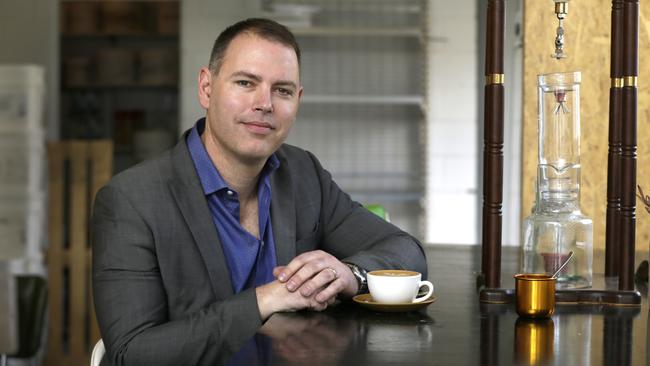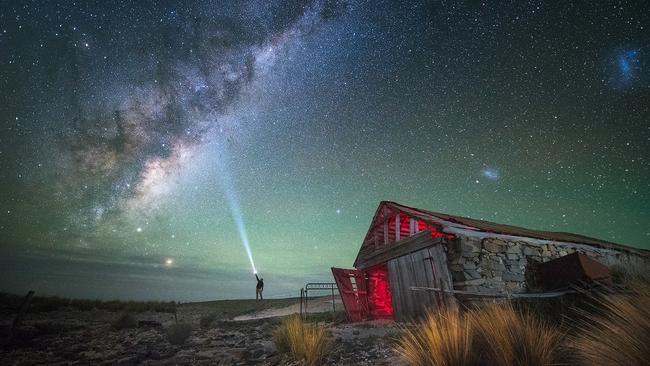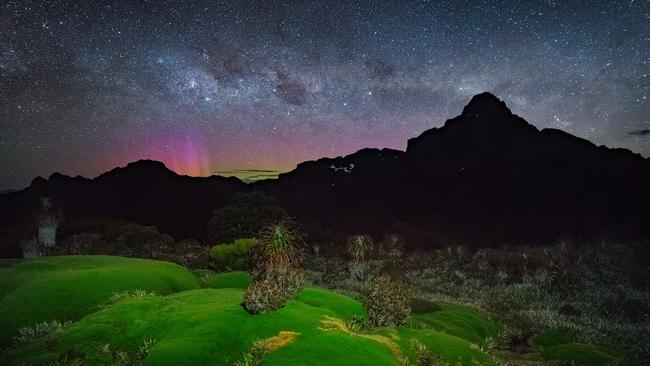Cafe Society: Dark Sky Tasmania urges Tasmanians to dim the lights and reclaim the night
A leading light in the dark sky movement is calling for Hobart to dim itself into a new future as a world capital of star-gazing.

Tasmania
Don't miss out on the headlines from Tasmania. Followed categories will be added to My News.
LANDON Bannister wants Tasmania to become a dimly lit world leader famous for its stargazing and the depth of its darkness.
With 80 per cent of the world living under artificial sky glow, Landon says the state is in a prime position to protect its natural darkness, and benefit in many ways.
Globally, fewer people each year can see the stars from where they live.
It’s a tragedy of literally astronomical proportions. And Landon has joined the Dark Sky movement in response.
The lighting professional and local leader of the International Dark-Sky Association is calling for new lighting laws to protect Tasmania’s natural darkness.
“Our vision is for Tasmania to be a world leader in dark-sky conservation and awareness, a dark state,” he says when we meet in broad daylight at Straight Up Roasters in Moonah.
“A dark state does not mean no artificial light at night. It’s about reversing the trends of light pollution, the inappropriate and excessive use of artificial light.”
MORE CAFE SOCIETY:
BRAYE SUTHERLAND: DRIVING A VISION FOR A GREEN STATE
SARAH ANDREWS: WORKING THE TOOLS TO SHARE OUR STATE
JESS ROBBINS: TASSIE A GLOBAL LEADER IN SUSTAINABILITY
ANDREA SENIOR: MORE SUPPORT FOR TASSIE FOSTER CARERS
HARVEY LENNON: WHY WE NEED TO WALK TO WORK MORE

Just walk up the upgraded Myer block of Liverpool St at night to see how horribly wrong Hobart is getting it sometimes, he says.
“It is excessively bright and glary and there is no human scale to it,” he says. “Making it brighter does not make it safer and it does not encourage people to use the space. There is plenty of evidence to show that. By evening, we need to scale it down, reduce the glare and warm it up.”
Landon fears the next lighting disaster may unfold at historic Salamanca, where a precinct revamp of roads and footpaths is under way.
“There is massive potential to screw up Salamanca,” he says. “Currently the lighting is relatively low-level with a warm orange glow, but if they change it and try to make it too ‘safe’ they will lose the entire charm – and contribute to light pollution.”
While he acknowledges the City of Hobart’s broad goal to reduce light pollution in its 2019-29 strategic plan, Landon worries it may come too late for Salamanca.
Having worked in the commercial lighting sector for many years, the 44-year-old says he can walk a city block and make unfortunately accurate predictions.
“I can walk past a small business and say ‘that place won’t last’, because the atmosphere and the lighting is totally wrong. You ignore lighting at your peril. If you are opening a cafe or bar or particularly any other evening business, it’s the most important money you spend.”
Think about a gently illuminated bar enhanced with candles on the tables, he suggests, waxing lyrical about the ancient light source. “There is nothing that makes a face more beautiful or captivating. And our response to that type of lighting is instantaneous. We relax.”
Scandinavia gets it right, he says, particularly with its interiors. And Paris is masterful with its facade and street lighting. In France, a new law imposes design and operation regulations for outdoor lighting of both public and private property.

It also specifies 11 sites of astronomical significance for additional protection. It all comes too late for Saint-Remy-de-Provence, says Landon of the town where Vincent Van Gogh painted his 1889 Starry Night masterpiece and where locals can no longer see the stars.
The wonderful thing about light pollution is that much of it is reversible. And Hobart is still relatively unpolluted, says Landon, even as he warns that we are inured to incremental loss by “boiling frog syndrome” – so slow we barely perceive the trajectory.
By 2030, Landon wants to see astrotourism well established in Tasmania. Landon points to the growing aurora-chasing community as just one promising niche.
“People spend tens of thousands of dollars to go and see the northern lights. We have the southern lights here on our doorstep.”
Landon’s 10-year vision includes capping light pollution at current levels and laws to control outdoor lighting, addressing intensity, duration and spectrum.
In 25 years, he wants to see light pollution reduced and for Hobartians to see far more stars than they could 20 years ago.
“We have a real affinity to wilderness here,” he adds, calling for extra protection for the Tasmanian Wilderness World Heritage Area, where true darkness is compromised in parts by both Hobart and Launceston lights.

“Tasmania has some of the darkest and most awe-inspiring skies in the world. We want a shift where people appreciate our night-time beauty as an intrinsic part of what we offer.”
Who’s getting it right already? Dark Mofo, with its embrace of darkness and firelight and paint-the-town red light globes. And who understood the power of the night sky all along? The Dutch master.
“There’s a Van Gogh quote we often use in presentations,” says Landon. “I know nothing with any certainty, but the sight of stars makes me dream.”


